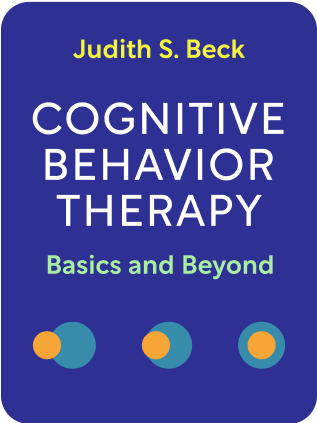

This article is an excerpt from the Shortform book guide to "Cognitive Behavior Therapy: Basics and Beyond" by Judith S. Beck. Shortform has the world's best summaries and analyses of books you should be reading.
Like this article? Sign up for a free trial here .
What can you learn from reading Cognitive Behavior Therapy: Basics and Beyond? What are the key takeaways from the book?
In Cognitive Behavior Therapy: Basics and Beyond, psychologist Judith Beck outlines the key elements of cognitive behavioral therapy. From this book, you can learn the basics of CBT, how to get distance from stressful thoughts, how to deal with traumatic events, and much more.
Keep reading for an overview of Cognitive Behavior Therapy: Basics and Beyond by Judith Beck.
Cognitive Behavior Therapy: Basics and Beyond
Do you ever find yourself in stressful situations, rationally knowing you shouldn’t be stressed? Have you stopped wishing you’d think self-defeating thoughts, mustering more courage to do the things you’ve wanted to do? You might find the idea from Cognitive Behavior Therapy: Basics and Beyond to be useful.
Cognitive behavioral therapy (CBT) is a standard first line of treatment for improving mental health disorders such as depression and anxiety. CBT has been found to be as effective as medication in treating many mental disorders. This overview of Judith Beck’s Cognitive Behavior Therapy: Basics and Beyond covers the principles of mental disorders and treatment, as well as tactics that are broadly applicable to your daily life, helping you overcome anxiety, sadness, anger, frustration, and stress.
While Cognitive Behavior Therapy: Basics and Beyond is a text to train psychiatry practitioners, many of the techniques can be applicable to daily life. Even if you aren’t formally diagnosed with a mental health disorder, you likely face situations that evoke more negative emotions than you’d like—nervousness talking to your boss, road rage, anxiety in social situations, stress that you won’t get everything done, or fear of failure in trying something new.
This summary of Cognitive Behavior Therapy: Basics and Beyond focuses on the key CBT interventions to change your dysfunctional automatic thoughts and behaviors. These are generally applicable for all readers, not just those aiming to practice CBT for patients.
When you feel dysphoria (negative emotion), think the cardinal question: “What was just going through my head?” Articulate the thought explicitly.
- e.g. “I’m afraid that people will think my project proposal is stupid.”
Evaluate the thought with these questions:
- What is the evidence that your thought is true? What is the evidence on the other side?
- What is an alternative way of viewing this situation? What else could explain the person’s behavior/the outcome?
- Outcome analysis
- What’s the worst that could happen? How would you cope with this situation?
- What’s the best that could happen?
- What’s the most realistic outcome of this situation? (especially if you tend to catastrophize)
- What is the effect of believing your negative automatic thought? What could be the effect of changing your thinking to be more positive?
- If your friend were in this situation and had the same automatic thought, what advice would you give him or her?
- What should you do going forward? How likely are you to do this?
Patterns of cognitive distortions: These put a label to common ways that people distort reality in self-defeating ways.
- Catastrophizing—imagining the worst possible thing that could happen
- Selective bias/tunnel vision/discounting the positive —focusing and emphasizing negative evidence for, ignoring or de-emphasizing positive evidence against
- All-or-nothing—either you get an A or you’re a total failure
- Mind reading—assuming negative intent or belief of other people, without considering other possibilities
- Emotional reasoning—because you feel it so strongly, it must be true
- I feel like a failure all the time, so it must be true
- Exaggeration, or overgeneralization
- Should and must statements—a precise fixed idea of how people should behave. Overestimate how bad it is if these expectations are failed
Conduct behavioral experiments to push yourself to do what is uncomfortable. This will give you new data, to find a mismatch between your prediction and reality.
- Realize that you can fall into a negative vicious cycle without intervention:
- Stressful situation arises
- Work asks you to work on a promising new project, but it risks failure. You get anxious.
- Automatic thoughts arise that cause a maladaptive, self-defeating reaction
- “I can’t succeed in this. If I fail, people will know and I’ll be ashamed.”
- A negative outcome results, further strengthening patient’s negative core beliefs and aggravating the automatic thoughts
- You don’t volunteer for the project. “I knew I wasn’t capable of signing up for this.”
- Patient also withdraws from situations that might lead to positive data
- You prevent yourself from volunteering for any future new projects, because the thought of doing so causes you too much anxiety.
- Stressful situation arises
- Small bits of positive data will counteract the vicious cycle. When done repeatedly, it can build its own virtuous cycle.
To uncover your deeper beliefs, keep asking yourself questions about the situation or the automatic thought. “What does it mean to me if X happens? What does it mean about me?”
- Articulate your rules, assumptions, and attitudes.
- Attitude: “It’s terrible to fail.”
- Rule: “If a challenge seems too great, don’t even try it.”
- Assumption: “If I try to do something difficult, I’ll fail. If I avoid doing it, I’ll be OK.”
Generally, dysfunctional core beliefs fall into three categories:
- Helplessness: “I want to achieve more, but I’m not capable of it.”
- Unlovableness: “I’m not worthy of being loved by others. I’m undesirable.”
- Worthlessness: “I’m bad. I’m fundamentally not worthy of good things.”
For beliefs, consider the following interventions:
- Phrase the rule/belief as an assumption—this makes it easier to spot the logical fallacy.
- “If I ask for help, I’ll be seen as weak.” vs “Don’t ask for help.”
- Present more functional beliefs, that are more qualified versions of the old belief
- “If I don’t get an A, I’m a failure.” -> “If I don’t get an A, I’m just human, and I still tried hard. It’s better than 0%.”
- “I can’t do anything right.” -> “I can do most things right, and there’s a good reason for when I get something wrong.” NOT “I can do everything right.”
- Behavior experiment
- Act “as if” the belief weren’t true.
- Act as if you assume the positive outcome will be true.
- Imagine counseling someone else with the same issue, or pretend your child has the same belief.
- Look back on major periods of patient’s life to find evidence that supports and contradicts the core belief
- Role playing an early traumatic experience. Play an older version of yourself, counseling your younger self on why the situation should be interpreted more optimistically.
- Make a list of advantages and disadvantages of each option. Score each entry to help make the ultimate decision.
- Continue imagining beyond the near future—weeks, months, years after whatever is causing dysphoria. Likely will find (inferring from past experience) that things will resolve satisfactorily.
Principles of Mental Disorders
The cognitive model proposes that dysfunctional thinking is common to all psychological disturbances. In this way, mental illnesses such as depression and anxiety may be considered thinking disorders. The patient has automatic dysfunctional self-talk that influences behavior negatively; the behavior is then interpreted in a negatively biased way, leading to worse thinking. This reinforces itself into a vicious cycle.
- Example: A patient wants to try something new. She thinks, “you’re definitely going to fail, you’re not good at anything.” → Anxious about failing, the patient declines to try the new activity. → She then thinks, “I told you, you can’t get anything right—you’re worthless.”
The negative thinking extends to the core of a patient’s beliefs about herself, the world, and other people, as well as intermediate levels of attitudes, rules, and assumptions the patient holds.
It’s not just the situation itself that makes a person feel a certain way, but also how they construe it, what lens they use to view it.
- Cyclical downfalls can be triggered by precipitating factors, such as a sudden provocation in stress.
- The patient may have had key developmental events earlier in life that predispose her to the condition.
- The patient may have developed coping mechanisms (adaptive and maladaptive) for the dysfunctional beliefs.
The key point of cognitive behavior therapy is that these dysfunctional beliefs can be unlearned.

———End of Preview———
Like what you just read? Read the rest of the world's best book summary and analysis of Judith S. Beck's "Cognitive Behavior Therapy: Basics and Beyond" at Shortform .
Here's what you'll find in our full Cognitive Behavior Therapy: Basics and Beyond summary :
- How to use CBT to overcome anxiety, sadness, anger, frustration, and stress
- How to address traumatic events earlier in your life, so that they have less hold on your thinking today
- The key ways to build rapport as a cognitive behavior therapist







Great overview of Cognitive Behavioral Therapy! I’ve been considering trying CBT for my anxiety, and this article provided a clear explanation of what to expect. The breakdown of core principles was especially helpful.